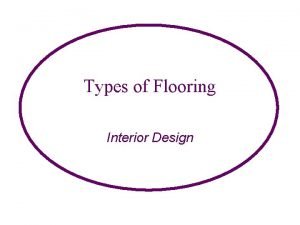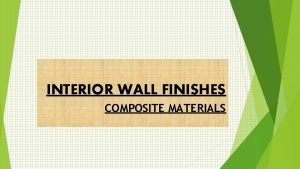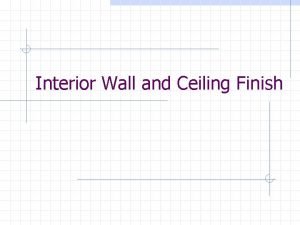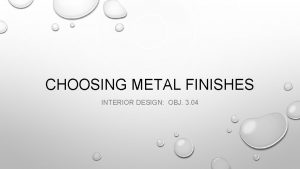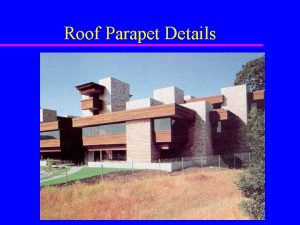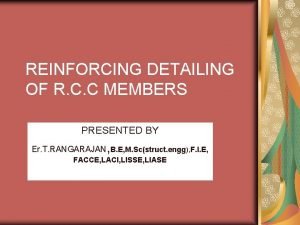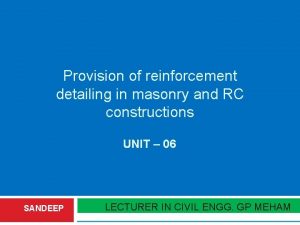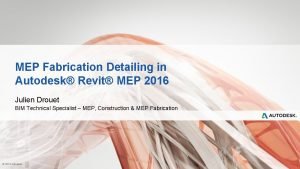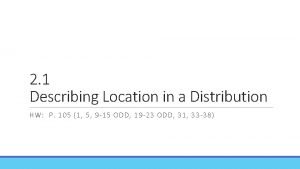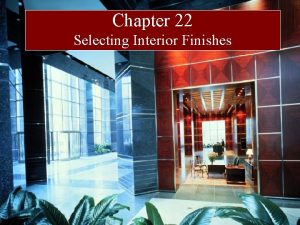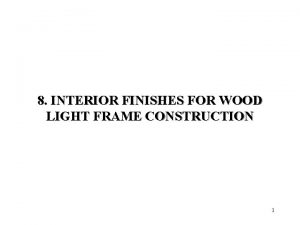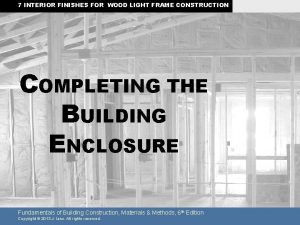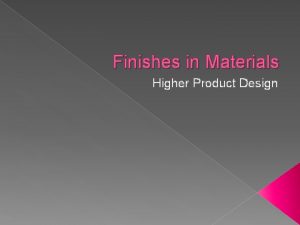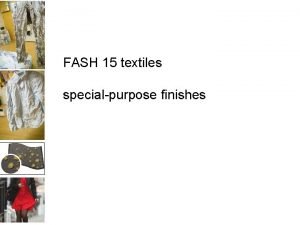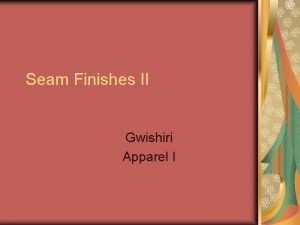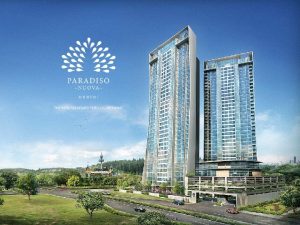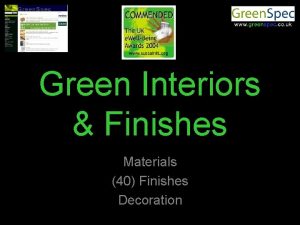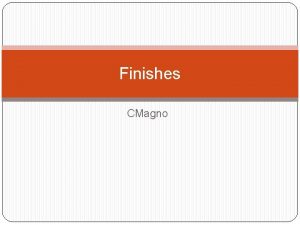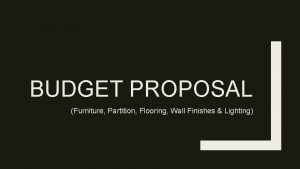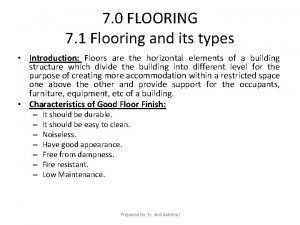Wood Flooring Interior Finishes and Detailing Wood flooring














- Slides: 14

Wood Flooring Interior Finishes and Detailing

Wood flooring • Wood flooring is either solid or engineered wood and is available as strip, plank, and parquet flooring. • Solid-wood flooring is commonly available in various hard - and softwood species. • Because it is very susceptible to the effects of moisture, it is generally unsuitable for below-grade applications. • Solid wood can be refinished many times.


• Engineered-wood flooring is made up of surface veneers, laminated to one or more supporting plies that add strength and dimensional stability. • Engineered-wood flooring is less susceptible to the effects of moisture than solid wood and can be used in belowgrade applications.

• Strip flooring is 11⁄2 - to 21⁄4 -inches (38 - to 57 -mm) wide and usually comes in random lengths • Plank flooring is 3 - to 8 -inches (76 - to 203 -mm) wide and usually comes in random lengths. • Parquet means a patterned floor. Parquet strips or planks are regular-length boards arranged in a pattern, such as a herringbone.

PRODUCT SELECTION CONSIDERATIONS • Flooring is a highly visible building finish that receives significant wear and abuse and impacts on the safety and comfort of occupants. It is subject to abrasion, water, dirt, and cleaning agents. When selecting wood flooring products and finishes, consider the following: 1. Amount and type of daily pedestrian traffic 2. Abrasiveness of local soils 3. Vehicular traffic (carts, wheelchairs, etc. ) 4. Exposure to moisture and fluctuations in relative humidity 5. Exposure to stains and reagents 6. Exposure to sunlight through glass; ultraviolet (UV) light may cause color changes 7. Exposure to in-service damage such as scratches, indentations, and gouges 8. Anticipated type and frequency of maintenance and its effect on appearance and slip resistance 9. Appearance expectations

Finishes • Finishes protect wood from wear, dirt, oxidation, and moisture. 1. Wax finishes over penetrating stains are the leastdurable finishes available. Generally, they are unsuitable for commercial applications. These finishes are the most susceptible to water damage and require buffing and periodic re-waxing. Wax finishes are factory or site applied.

2. Surface finishes over penetrating stains are durable and require little maintenance. Oil-modified and water-based polyurethanes are used most. Shellacs, manufactured and natural varnishes, and lacquers are rarely used. Epoxy-ester finishes are very durable and are recommended for gym floors. Moisture-cured urethanes and acid-curing formaldehyde finishes are also very durable but are difficult to apply and have a high VOC content. Generally, water-based finishes are clear and non-yellowing and leave the wood with the most natural appearance. Solvent- and oil-based finishes tend to yellow with age and change the appearance of stained or natural wood. Surface finishes are factory or site applied.

3. Acrylic-impregnated finishes are the most durable. For these finishes, the wood is saturated with chemicals that polymerize into solid acrylic. Because the chemical reaction occurs throughout the thickness of the wood, it increases the density, hardness, and wear resistance of the wood flooring product. Acrylic seals the wood against moisture and, therefore, increases dimensional stability. Acrylic impregnated finishes are factory applied.

APPLICATION CONSIDERATIONS 1. Controlling the moisture content of wood is critical both before and after installation. Wood is hygroscopic, meaning it changes dimensionally with the absorption or release of moisture. Swelling and shrinking varies with the wood species, cut, and type of flooring. Moisture control for engineered- wood flooring is less critical than for solid-wood flooring. During transit, delivery, and storage, it must be protected from moisture. Before installation, wood flooring must stabilize at the temperature and relative humidity of space in which it will be installed

2. Wood flooring installations must accommodate movement. An expansion space is required at the perimeter of the installation.

3. Concrete slab substrates must be dry and protected from subsurface moisture by appropriate grading and drainage, a capillary water barrier of porous drainage materials, and a membrane vapor retarder.

4. For adhesive attachment to concrete, slabs must be clean and free of curing compounds, sealers, hardeners, and other materials that may interfere with an adhesive bond

5. Spaces below wood flooring must be dry and well ventilated. Cross-ventilate crawl spaces and cover the ground with a polyethylene vapor retarder.
 Semi hard flooring types
Semi hard flooring types Interior wall finishes material
Interior wall finishes material Finishing materials meaning
Finishing materials meaning Interior design metal finishes
Interior design metal finishes Bbn detailing - mobile
Bbn detailing - mobile Types of parapet roof
Types of parapet roof L=8
L=8 Beam detailing
Beam detailing Stamm auto detailing
Stamm auto detailing Practical design to eurocode 2
Practical design to eurocode 2 Detailing connect
Detailing connect Dalhousie academic detailing
Dalhousie academic detailing Mark receives a score report detailing his performance
Mark receives a score report detailing his performance Papercut qr doc
Papercut qr doc Academic detailing definition
Academic detailing definition
